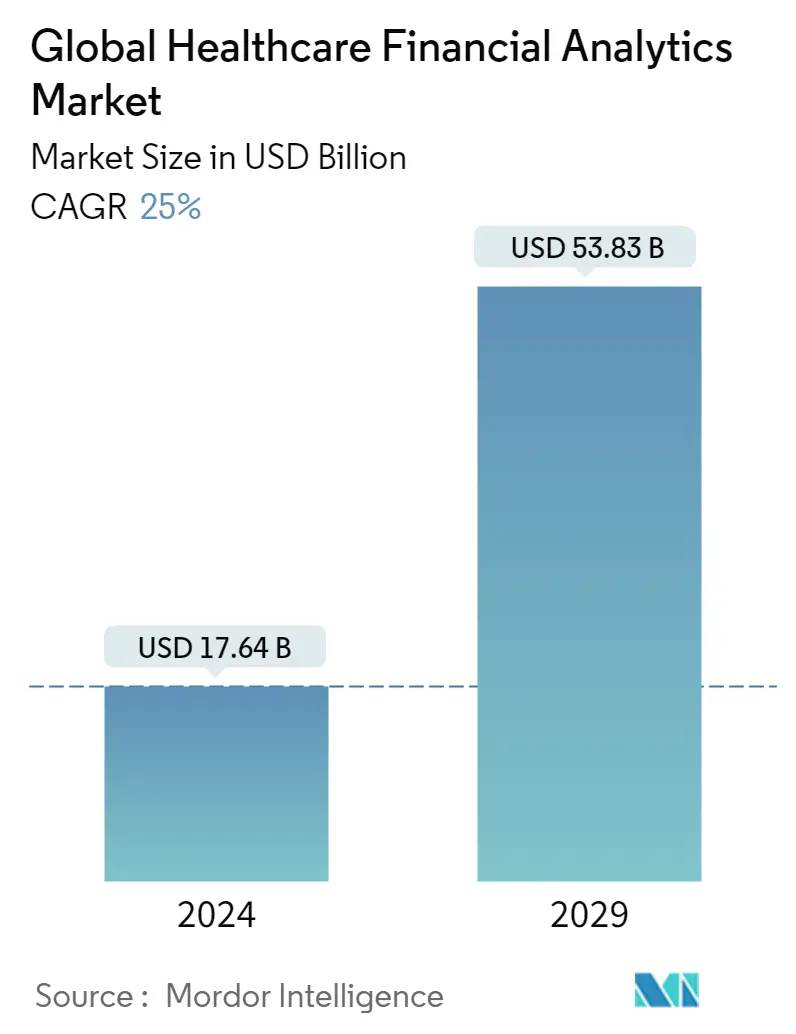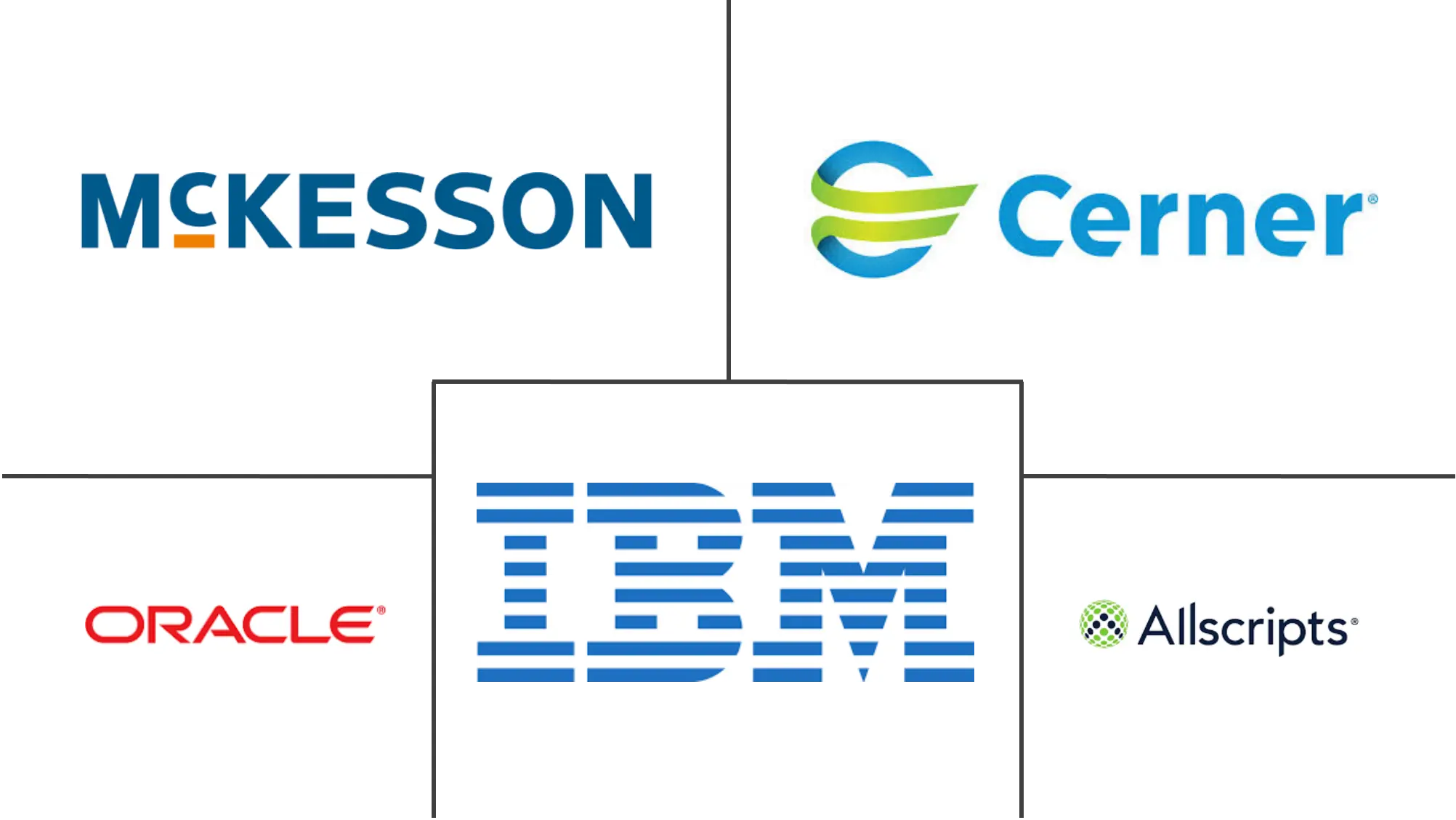Market Size of Global Healthcare Financial Analytics Industry

| Study Period | 2019 - 2029 |
| Market Size (2024) | USD 17.64 Billion |
| Market Size (2029) | USD 53.83 Billion |
| CAGR (2024 - 2029) | 25.00 % |
| Fastest Growing Market | Asia Pacific |
| Largest Market | North America |
Major Players
*Disclaimer: Major Players sorted in no particular order |
Healthcare Financial Analytics Market Analysis
The Global Healthcare Financial Analytics Market size is estimated at USD 17.64 billion in 2024, and is expected to reach USD 53.83 billion by 2029, growing at a CAGR of 25% during the forecast period (2024-2029).
The pandemic had an adverse effect on the healthcare financial analytics market. Healthcare analytics is under pressure for a number of reasons, according to an article titled "Tips to Streamline Your RCM Process During COVID-19 Pandemic" which was published in April 2020. First of all, the requirement to record patients with previously unrecorded conditions has caused a great deal of misunderstanding and procedural chaos. Second, billers and coders must keep up with shifting payer needs and coding standards at a rate far faster than the average learning curve. Thirdly, charging for COVID-19 patients must differ from standard billing because the therapy is linked to a pandemic with numerous accompanying regulatory body constraints that have an effect on the market. However, with COVID-19 in the scenario, Telehealth has emerged as an effective method for patients to interact between patients and healthcare providers. This has provided the flexibility to schedule remote appointments to provide initial screenings, offer second opinions, and follow-up with patients which will prevent the spread of the virus. The increase in the digitalization process has increased the demand for more transparent billing procedures, thus driving the market. The European Commission suggested the EU4Health program as a component of a COVID-19 recovery response program, according to an article titled "The European digital health revolution in the wake of COVID-19" that was published in April 2021. The effort intends to raise EUR 5.1 billion for the European health sector's digital transformation and to assure readiness for potential future international health concerns. Therefore, the market expansion throughout the study period will be driven by rising government investments in the digital transformation of healthcare. Thus, COVID-19 has impacted adversely the demand for healthcare analytics, but it is expected to recover with the increase in the number of inpatients and outpatients number.
Big data analytics is a fast-emerging topic in healthcare analytics. The emerging blend of bioinformatics and health informatics has encouraged research in all the healthcare segments, such as target drug, personalized medicine, clinical decision support, and population health management. A core voluntary contribution (CVC) of EUR 340 million over four years was initiated by the Prime Minister of the United Kingdom in September 2020 to support all of the WHO's activities in the nation as outlined in the 13th General Programme of Work. As a result, a number of government measures are to blame for the adoption of RCM platforms, which contribute to the market's expansion. In 2020, National Health Service (NHS) England allocates funds to 191 Clinical Commissioning Groups, which govern and pay for care delivery at the local level. The NHS provides free public health care, including hospital, physician, and mental health treatment, to all national residents on an automatic basis. The NHS is responsible for determining the strategic direction of health information technology, including the creation of online appointment booking systems and the establishment of quality standards for prescription and medical record-keeping software. As a result, the market under study will be driven by the usage of revenue cycle management software for better reimbursement processes. Additionally, initiatives by key market players are another factor in market growth. For instance, in August 2020, Quantzig launched advanced clinical data analytics solutions to help healthcare, pharma, and life science companies lead their way out of the pandemic with data-driven insights. Thus, the abovementioned factors are expected to increase market growth.
However, the lack of properly trained IT professionals in healthcare is expected to hinder the market growth.
Healthcare Financial Analytics Industry Segmentation
As per the scope of the report, financial analytics is a part of advanced analytics that are required for claims processing, payment integrity and fraud, waste, and abuse (FWA), and risk assessment. The Healthcare Financial Analytics Market is Segmented by Type (Claim Analytics, Revenue Cycle Management, Risk Management Analytics, and Others), Component (Hardware and Software & Services), Deployment (On-premise and Cloud-based), and Geography (North America, Europe, Asia-Pacific, Middle East and Africa, and South America). The market report also covers the estimated market sizes and trends for 17 different countries across major regions, globally. The report offers the value (in USD million) for the above segments.
| By Type | |
| Claim Analytics | |
| Revenue Cycle Management | |
| Risk Management Analytics | |
| Others |
| By Component | |
| Hardware | |
| Software & Services |
| By Deployment | |
| On-premise | |
| Cloud-based |
| Geography | ||||||||
| ||||||||
| ||||||||
| ||||||||
| ||||||||
|
Global Healthcare Financial Analytics Market Size Summary
The healthcare financial analytics market is poised for significant growth, driven by the increasing digitalization of healthcare processes and the rising demand for transparent billing procedures. The market, which experienced a temporary setback due to the COVID-19 pandemic, is expected to recover and expand as the number of inpatients and outpatients rises. The integration of big data analytics, bioinformatics, and health informatics is fostering advancements in various healthcare segments, including personalized medicine and population health management. Government initiatives and investments, particularly in Europe and North America, are further propelling the market by supporting the digital transformation of healthcare systems. The adoption of revenue cycle management software and cloud-based analytics solutions is enhancing reimbursement processes and improving data management across healthcare facilities.
Despite the promising growth trajectory, the market faces challenges such as a shortage of trained IT professionals in healthcare. However, the increasing acceptance of cloud computing and the demand for better claims and revenue management systems are expected to drive market expansion. Strategic collaborations and technological advancements, such as those seen in the United Kingdom's NHS and Germany's sovereign cloud services, are contributing to the market's development. In North America, the healthcare financial analytics market is benefiting from technological advancements and federal government initiatives that promote data transparency and the use of electronic medical records. The market is characterized by the presence of major players like IBM, Cerner Corporation, and Oracle Corporation, who are actively involved in shaping the future of healthcare analytics through strategic acquisitions and partnerships.
Global Healthcare Financial Analytics Market Size - Table of Contents
-
1. MARKET DYNAMICS
-
1.1 Market Overview
-
1.2 Market Drivers
-
1.2.1 Emergence of Big Data in Healthcare
-
1.2.2 Growing Awareness For Digital Technologies
-
1.2.3 Technological Advancements Making Data Handling Easy
-
-
1.3 Market Restraints
-
1.3.1 Lack of Properly Trained IT Professionals in Healthcare
-
-
1.4 Porter's Five Forces Analysis
-
1.4.1 Threat of New Entrants
-
1.4.2 Bargaining Power of Buyers/Consumers
-
1.4.3 Bargaining Power of Suppliers
-
1.4.4 Threat of Substitute Products
-
1.4.5 Intensity of Competitive Rivalry
-
-
-
2. MARKET SEGMENTATION (Market Size by Value - USD million)
-
2.1 By Type
-
2.1.1 Claim Analytics
-
2.1.2 Revenue Cycle Management
-
2.1.3 Risk Management Analytics
-
2.1.4 Others
-
-
2.2 By Component
-
2.2.1 Hardware
-
2.2.2 Software & Services
-
-
2.3 By Deployment
-
2.3.1 On-premise
-
2.3.2 Cloud-based
-
-
2.4 Geography
-
2.4.1 North America
-
2.4.1.1 United States
-
2.4.1.2 Canada
-
2.4.1.3 Mexico
-
-
2.4.2 Europe
-
2.4.2.1 Germany
-
2.4.2.2 United Kingdom
-
2.4.2.3 France
-
2.4.2.4 Italy
-
2.4.2.5 Spain
-
2.4.2.6 Rest of Europe
-
-
2.4.3 Asia-Pacific
-
2.4.3.1 China
-
2.4.3.2 Japan
-
2.4.3.3 India
-
2.4.3.4 Australia
-
2.4.3.5 South Korea
-
2.4.3.6 Rest of Asia-Pacific
-
-
2.4.4 Middle-East and Africa
-
2.4.4.1 GCC
-
2.4.4.2 South Africa
-
2.4.4.3 Rest of Middle-East and Africa
-
-
2.4.5 South America
-
2.4.5.1 Brazil
-
2.4.5.2 Argentina
-
2.4.5.3 Rest of South America
-
-
-
Global Healthcare Financial Analytics Market Size FAQs
How big is the Global Healthcare Financial Analytics Market?
The Global Healthcare Financial Analytics Market size is expected to reach USD 17.64 billion in 2024 and grow at a CAGR of 25% to reach USD 53.83 billion by 2029.
What is the current Global Healthcare Financial Analytics Market size?
In 2024, the Global Healthcare Financial Analytics Market size is expected to reach USD 17.64 billion.

